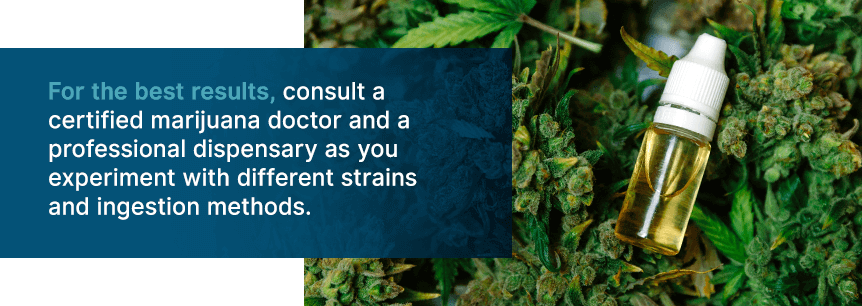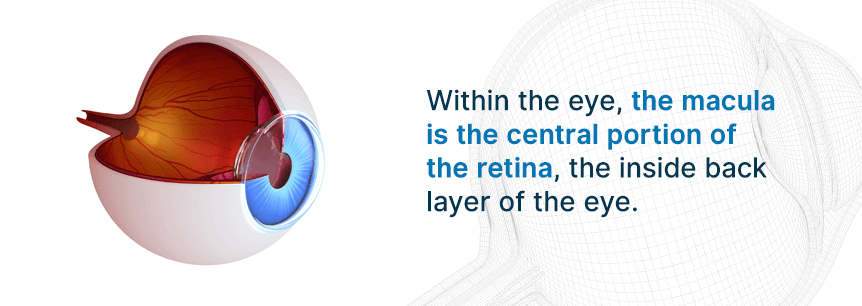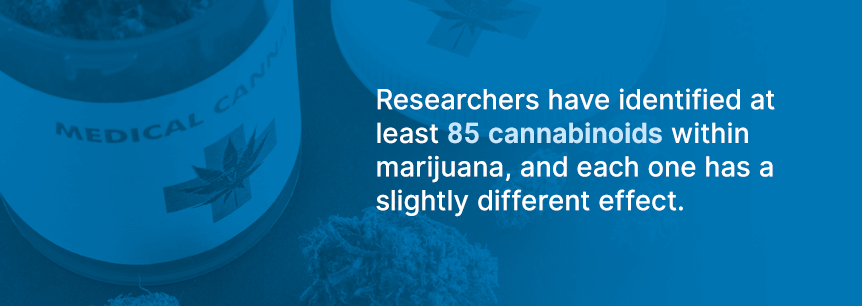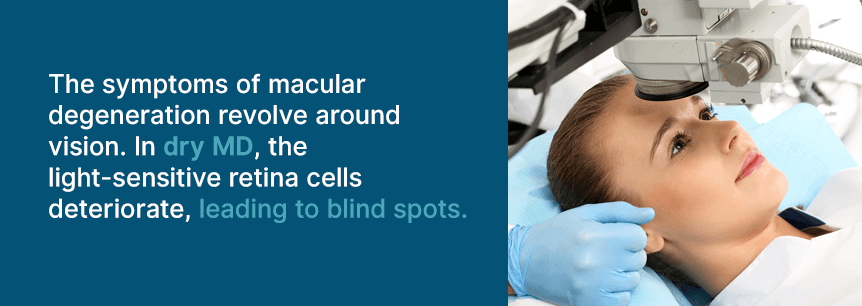
Most likely, you know someone who has been touched by macular degeneration (MD). The leading cause of vision loss across the United States, MD affects over 10 million Americans of all ages, which is more than glaucoma and cataracts combined.
If you are interested in exploring alternative treatment for macular degeneration, medical marijuana provides a holistic and effective option. Before we dive into the potential of cannabis for treating MD, we will cover the disease, its symptoms, and available treatments.

Until recently, marijuana has been considered an illegal substance across much of the world. Historically, it has been hard to acquire research permits, making the study of cannabis difficult. Marijuana research is a new and growing field, and currently, no research has been directly conducted on the effect of cannabis on MD.
Find A Doctor Find A Dispensary
However, what we do know of cannabis indicates that it might help manage and reduce the symptoms of MD. Recent studies have produced promising results — ECS receptors have been found around the ocular region, and consuming cannabis has been found to reduce inflammation, inhibit vascular endothelial growth factor and lower intraocular pressure.
Cannabis is a known anti-inflammatory substance, helping a wide range of inflammatory disorders including arthritis and Crohn’s disease. However, cannabis doesn’t just target system-wide inflammation — marijuana has shown anti-inflammatory properties specifically for the area around the retina.
This effect is especially seen when the inflammation is connected with diabetes or endotoxin exposure, and both conditions have correlations with MD. Bacterial endotoxins can often be the instigating cause of macular degeneration, and diabetes is shown to be a risk factor of MD.
CBD, in particular, reduces the body’s production of cytokines, pro-inflammatory proteins. Additionally, the cannabinoid decreases the activation of vital factors in the inflammation response, lowering the activity of primary pathways that help regulate pro-inflammatory genes.
In general, Sativa strains of marijuana are high with THC compounds, while Indica strains have high CBD levels. The best strains of cannabis to fight inflammation include:
Because CBD shows particular results in reducing inflammation, Indica strains or hybrids with a high Indica content are the best choices for anti-inflammatory treatment.
Many treatments for MD patients involve injections directly into the eye. These medications aim to halt the growth of vascular endothelial growth factor. But while these treatments often come with harsh side effects, cannabis has been shown to have the same effect with little to no negative repercussions.
In a 2004 study of brain tumors, researchers found that cannabinoids blocked and inhibited VEGF pathways through the body, showing incredible promise for cannabis as a treatment for macular degeneration. THC seems to be especially effective at targeting VEGF progression, so for balanced results, try a balanced hybrid or a slightly-THC leaning strain such as the ones below.
When looking for the right strain of medical marijuana for your unique needs, work closely with a certified marijuana doctor and dispensary — they will be able to give you personalized and expert insight into finding the ideal type of cannabis.
Medical marijuana has been shown to lower intraocular pressure for patients with glaucoma. Glaucoma is associated with MD, and many patients will develop both conditions. The implications of this research are exciting — while researchers need to conduct further studies, medical marijuana appears to significantly help both eye conditions.
Since ocular ECS receptors have been discovered, researchers hypothesize that topical application of medical cannabis may be just as effective in reducing pressure around the eye.
Many people with macular degeneration develop depression as a reaction to learning they may lose their sight. Older adults are particularly at risk, with studies showing nearly 40 percent of older adults with MD also have depression. This is six percent higher than depression rates among individuals with other visual impairments, and 24 percent higher than rates in normally-sighted individuals.
CBD has already been shown to have antidepressant qualities and can ease many of the symptoms of depression and anxiety.
While more studies need to be conducted on the effects of CBD on macular degeneration, anecdotal evidence suggests that cannabis can profoundly help patients with MD.
Marijuana is a natural and holistic alternative to typical medications for macular degeneration. But as with any treatment, cannabis comes with a few potential side effects. However, almost all the negative side effects of marijuana use can be lessened or eliminated by taking a few extra steps.
Here are a few of the most common side effects of medical cannabis use:
Like any drug, marijuana will affect every person differently. For the best results, consult a certified marijuana doctor and a professional dispensary as you experiment with different strains and ingestion methods.

Smoking a joint is the stereotypical image of marijuana use. However, cannabis products come in a wide range of types and styles, from tinctures and sprays to edibles.
Here are some of the most popular ways to consume medical cannabis:
Even if you have used marijuana before, experiment with a few different methods — you might find a new favorite.
Macular degeneration is often a frightening and discouraging condition. However, medical marijuana could give you or someone you love hope — if you are interested in pursuing medical cannabis as a treatment for MD, let MarijuanaDoctors.com help.
With an extensive directory of certified marijuana doctors and professional dispensaries, we have the resources you need to find experts near you. Let us help you heal — search for a qualified dispensary and physician today.
Find A Doctor Find A Dispensary
Within the eye, the macula is the central portion of the retina, the inside back layer of the eye. The retina receives images and sends them to the optic nerve, which in turn sends signals to the brain to help interpret what we are seeing.

The macula is responsible for focusing the central vision of the eye. Without the macula, we couldn’t recognize colors or faces, which would make us unable to drive, read or see objects in detail.
With macular degeneration, the macula gradually deteriorates. As the cells begin to fail, images aren’t received properly, leading to blurred and distorted vision. Eventually, a blind spot will develop in the center of a patient’s vision. As MD progresses, the blind spot expands until all central sight is lost completely, although peripheral vision remains intact.
Macular degeneration occurs in two basic types — dry and wet MD.
Almost all MD is considered dry, or atrophic — around 85 to 90 percent of macular degeneration cases fall into this category.
In dry MD, blood or serum doesn’t leak into the retina. Instead, the deterioration of the macula is due to small, yellow deposits of amorphous and acellular debris called drusen. The formation of drusen causes the macula to thin and dry out, which ultimately leads to loss of function.
Almost all people over the age of 50 will have at least some drusen in their retina, but only large drusen deposits lead to MD. Dry MD tends to progress more slowly than wet MD, and vision loss is often less serious.
Wet, or exudative, macular degeneration occurs in roughly 10 to 15 percent of MD cases. This form progresses rapidly, often leading to severe vision loss and impairment.
In wet MD, abnormal blood vessels called choroidal neovascularization (CNV) form under the retina. As they grow, CNV vessels tend to bleed and leak fluid into the macula. This influx of fluid makes the macula lift or bulge, which damages and distorts central sight.
A sign of wet MD is a dark blind spot in the middle of a patient’s vision. Often, straight, clear lines appear distorted, blurred or wavy. While peripheral vision is typically unaffected by wet MD, patients can lose most or all of their central sight.
Macular degeneration is grouped into three stages of progression — early, intermediate and late MD.
The exact causes of macular degeneration are unknown, and we need more research to fully understand the disease. However, the cause of MD is thought to be a combination of both hereditary and environmental factors.

Researchers have identified several risk factors for developing MD, including the following:
The symptoms of macular degeneration revolve around vision. In dry MD, the light-sensitive retina cells deteriorate, leading to blind spots. Alternatively, people with wet MD are more likely to notice wavy and distorted lines and details as fluid leaks into the macula.

Here are some of the most common symptoms of macular degeneration:
Typically, dry MD occurs in both eyes. If only one eye is affected, the patient may not notice any significant vision changes — the good eye will compensate for the affected one.
Macular degeneration is considered an incurable disease. However, a range of treatment options tries to slow the progression of MD.
For the early stages of dry MD, treatment often involves nutritional therapy. Supplements high in antioxidants, omega-3 fatty acids and carotenoids are prescribed to strengthen cell structure and increase healthy pigments.
Wet MD typically involves one of two treatment options — laser photocoagulation treatments and anti-VEGF therapy.
Until recently, laser therapy was the only way to stop leaking blood vessels in wet MD. After a laser sealed the vessels, the treatment was followed by Photodynamic Therapy (PDT) using Visudyne. This drug was injected intravenously, and while successful in sealing vessels, it does not affect reoccurrence, leading to a 50 percent chance that leakage developed again in a two-year span.
Additionally, Visudyne comes with a host of side effects including tiredness, headaches, chest pain, sweating, and eye pain.
Currently, one of the most common treatments for MD targets the vascular endothelial growth factor (VEGF). VEGF is a molecule responsible for supporting new blood vessels. However, when the macula is damaged, VEGF is a harmful element that promotes the development of new, unhealthy and weak blood vessels in the retina.
Anti-VEGF therapy involves periodic injections of an anti-VEGF chemical into the eye. These chemicals inhibit the growth of any new blood vessels in the macula, leading to a temporary halt in the progression of MD.
Several anti-VEGF chemicals are used to treat MD, including bevacizumab, ranibizumab, and aflibercept. Potential side effects of the drugs include increased eye pressure, eye infection, vitreous floaters and retinal detachment.
Before we explore how marijuana treats macular degeneration, we must first go into how cannabis works.
Marijuana interacts with the body’s natural endocannabinoid system (ECS). Researchers are still analyzing the role of the ECS, but what we have learned so far is astonishing. According to current research, the ECS plays a vital role in maintaining homeostasis in the body. It helps regulate a wide range of functions, including metabolism, appetite, immune response, memory, and intercellular communication.
The ECS has two different types of receptors — CB1 and CB2. While CB2 receptors occur throughout the peripheral nervous system and the immune system, CB1 receptors primarily cluster in the brain and spinal cord. When you consume cannabis, it enters the bloodstream and binds to either CB1 or CB2 receptors.
Marijuana is filled with chemical compounds called cannabinoids. Researchers have identified at least 85 cannabinoids within marijuana, and each one has a slightly different effect. The two primary cannabinoids are tetrahydrocannabinol (THC) and cannabidiol (CBD). Their main difference revolves around which ECS receptors they bind to — while THC primarily targets CB1 receptors, CBD mainly binds to CB2 receptors.
Because it binds to the receptors in the brain and spinal cord, THC is known as the cannabinoid that causes psychoactive effects. Alternately, CBD doesn’t affect the brain — primarily targeting the immune system, CBD gives all the therapeutic benefits of weed without the “high.”
Although recreational users often prefer marijuana with high levels of THC, medical marijuana is often dominant with CBD.


Please allow us to access your location to find local dispensaries.
VIEW ALL DISPENSARIES ➔